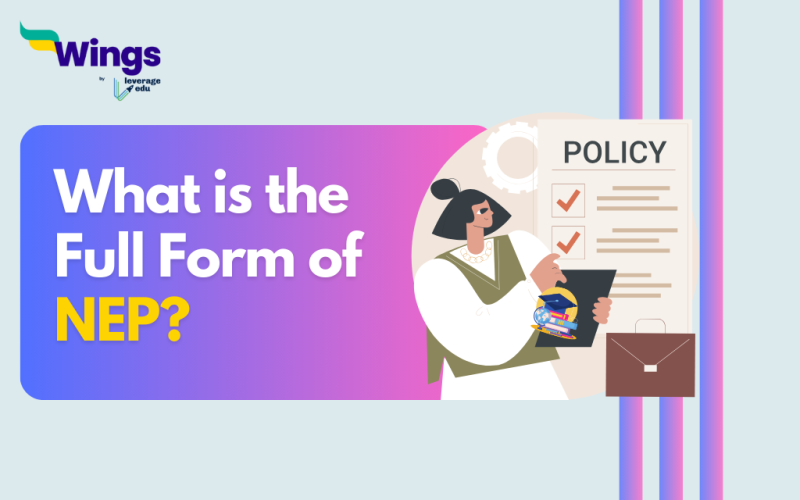The full form of NEP is the National Education Policy. The NEP 2020 attempts to shape India’s educational system of the future with new improvements. Moreover, on the 29th of July, 2020, the Union Cabinet of India approved the NEP. In addition, the NEP provides a comprehensive framework for education from early childhood to higher education in both rural and urban India, teacher education, gender inclusion, as well as vocational education. The initiative aims to fundamentally revamp India’s educational system by 2030.
Also Read: What is the Full Form of B.Ed?
What is the Background of NEP?
The National Policy on Education from 1986 has been updated to NEP 2020. The NEP consultation process was led on the 15th of January by a former Cabinet Secretary T.S.R. Subramanian. According to the committee’s report from June 2017, a team of members employed under the direction of former ISRO director Krishnaswamy Kasturirangan presented the draft of NEP in 2019. Furthermore, the draft was around 484 pages. Thereafter, the Ministry of Human Resource Development produced the Draft of New Education Policy (DNEP) 2019 which was the subject of several public discussions. The Ministry conducted a thorough consultation process.
Also Read: What is the Full Form of NCF?
What are the NEP Provisions?
The Provisions of NEP 2020 are as follows:
Early Childhood Care and Education (ECCE): The NEP 2020 highlights the significance of early childhood education and strives to impart foundational learning to children aged 3-6 through Anganwadis and pre-schools.
School Education: The policy endeavors to instill a multidisciplinary and holistic approach to school education by prioritizing critical thinking, experiential learning, and a reduction in reliance on rote memorization. Moreover, it advocates for the utilization of the mother tongue or local language as the medium of instruction, at least until Grade 5.
Curricular Reforms: NEP 2020 introduces a new 5+3+3+4 curricular structure thus replacing the existing 10+2 system. This new framework spans 12 years of schooling by categorizing stages as foundational (ages 3-8), preparatory (ages 8-11), middle (ages 11-14), and secondary (ages 14-18). Furthermore, the policy encourages a flexible curriculum encompassing a diverse array of subjects and promotes vocational education.
Teacher Education: The NEP policy focuses on boosting the quality of educators through the introduction of a four-year integrated B.Ed. program and a standardized National Professional Standards for Teachers (NPST) framework. Additionally, it aims to provide continuous professional development opportunities for teachers throughout their careers.
Technology in Education: The NEP strives to seamlessly integrate technology into teaching and learning processes. It supports the utilization of online and digital resources, virtual labs, and e-learning platforms to enhance the accessibility and quality of education.
Gender Inclusion: It aims to provide equal opportunities for girls and transgender students. NEP calls for the eradication of gender-based discrimination and the promotion of gender-sensitive education.
Assessment Reforms: The policy advocates for a shift from a summative assessment system to a competency-based and formative assessment approach. Moreover, NEP aims to diminish the emphasis on board exams.
Financial Support: The policy underscores the necessity for heightened public investment in education, recommending the allocation of 6% of India’s GDP to this sector. Additionally, it aims to augment the availability of scholarships, loans, and financial aid to support students.
What are the Languages included in NEP?
In India, there are numerous languages in different states. The use of our mother tongue or local language as a medium of instruction until Class 5 has been “emphasized” by the National Education Policy 2020. Moreover, it is recommended that it should be maintained until Class 8 and beyond. The use of foreign languages and Sanskrit will be highlighted as well. It also states that children will not be pushed to learn a language.
Must Read: What is the Full Form of VAT?
Advantages of NEP
Following are the advantages of the New Education Policy 2020
Holistic Development: This policy works to emphasize holistic development through the means of a multidisciplinary approach. It tries to incorporate life skills, critical thinking, creativity, as well as communication skills, apart from academics, into the curriculum of students.
Flexibility: The policy offers flexibility allowing students to choose from various subjects and hence gives them a larger field to pursue their interests. This caters to the diverse talents and aspirations of students.
Vocational Education: This policy focuses on the importance of vocational skills and thus it incorporates these skills in the curriculum early on. This helps students acquire practical skills and makes them more employable and ready for the professional world.
Multilingualism and Inclusivity– The new policy aims at recognizing the regional sheet of India and promoting the language of different cultures. Hence increasing inclusivity in nature.
Popular Full Forms
We hope this blog has helped you understand the full form of NEP and everything related to it. If you want to know more, find the 300+ full forms list on our blog. In the world of short forms, you can rely on the Leverage edu page to know about more full forms like this! Connect with us study abroad experts to achieve your international dream today!
 One app for all your study abroad needs
One app for all your study abroad needs













